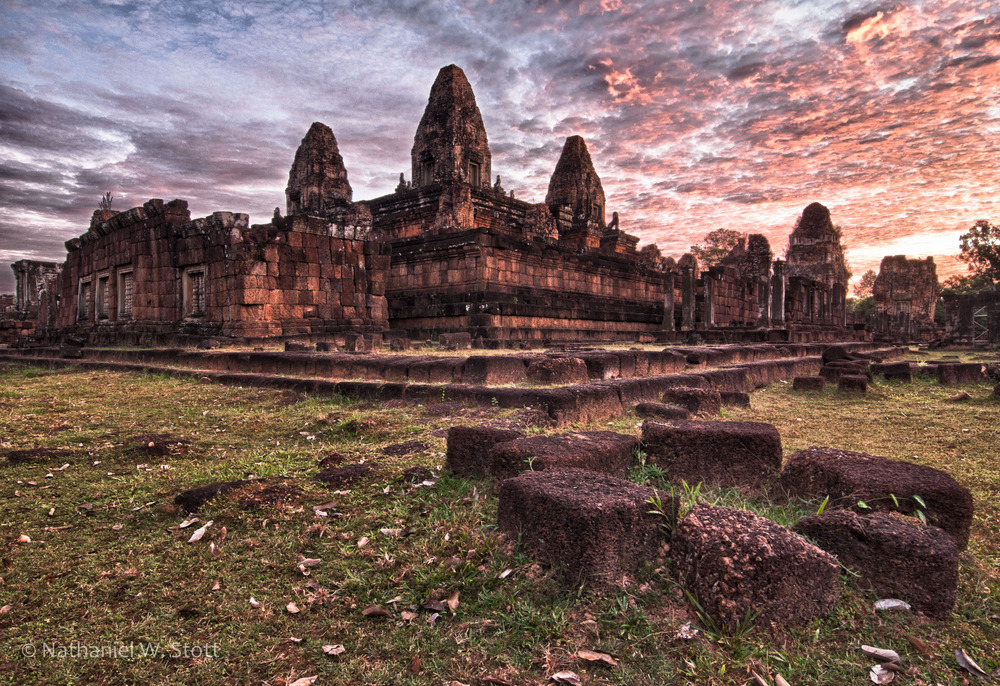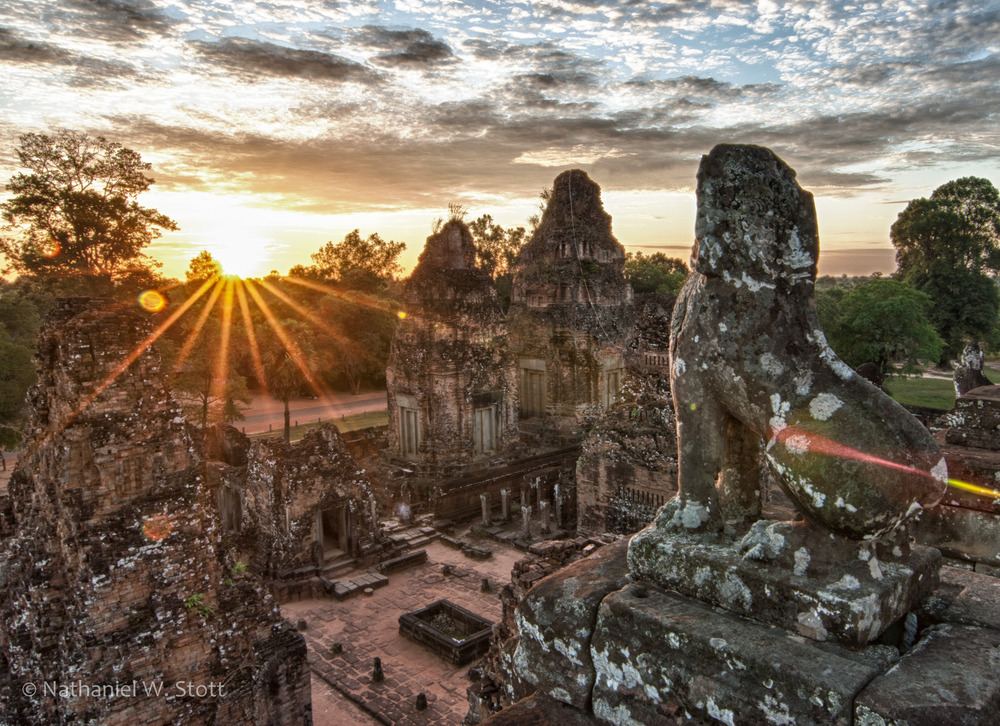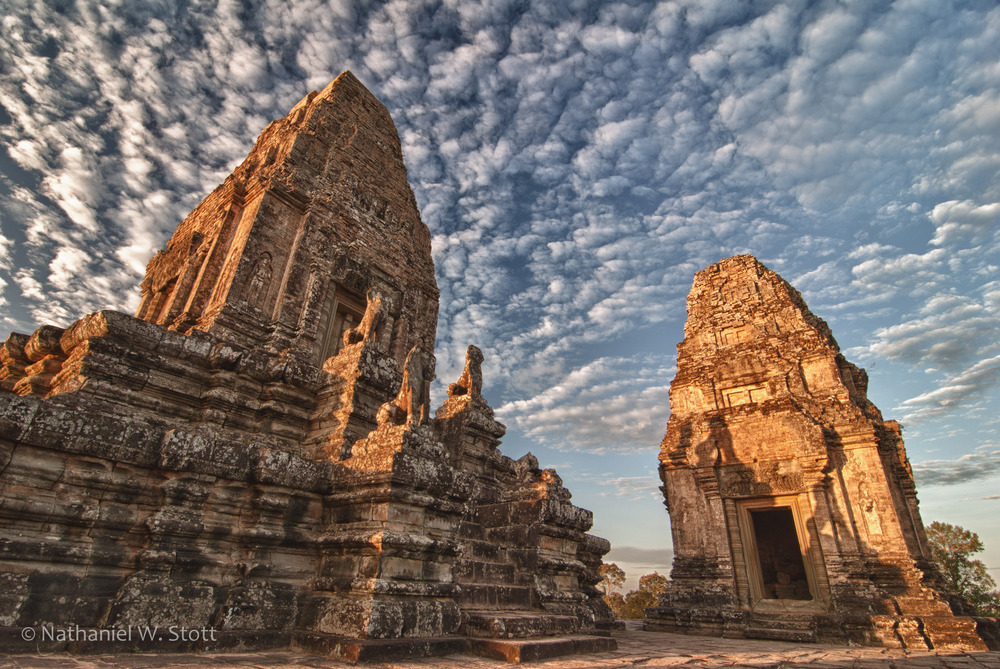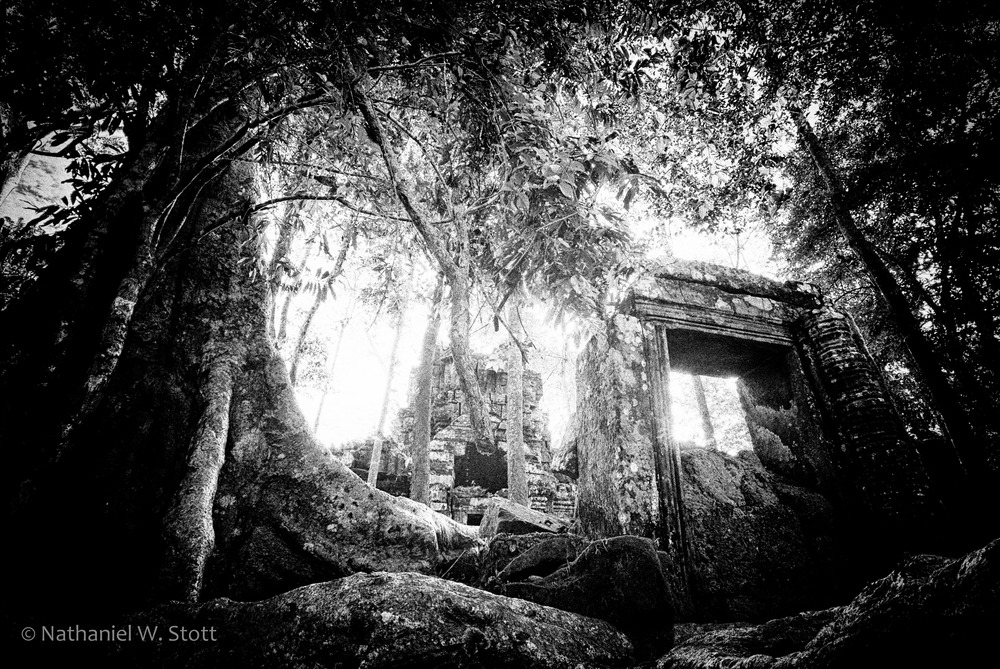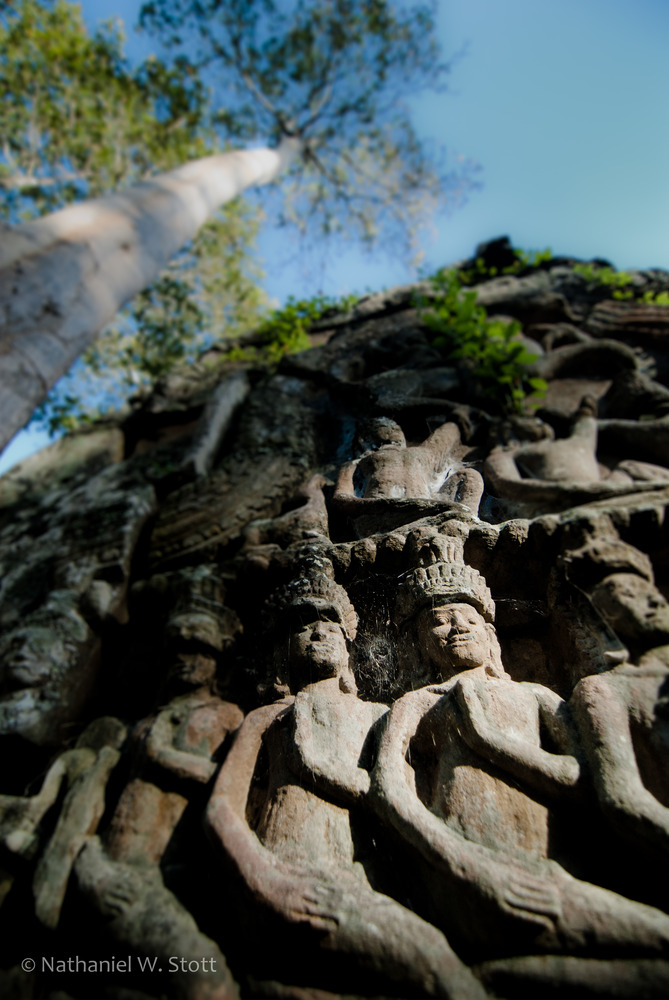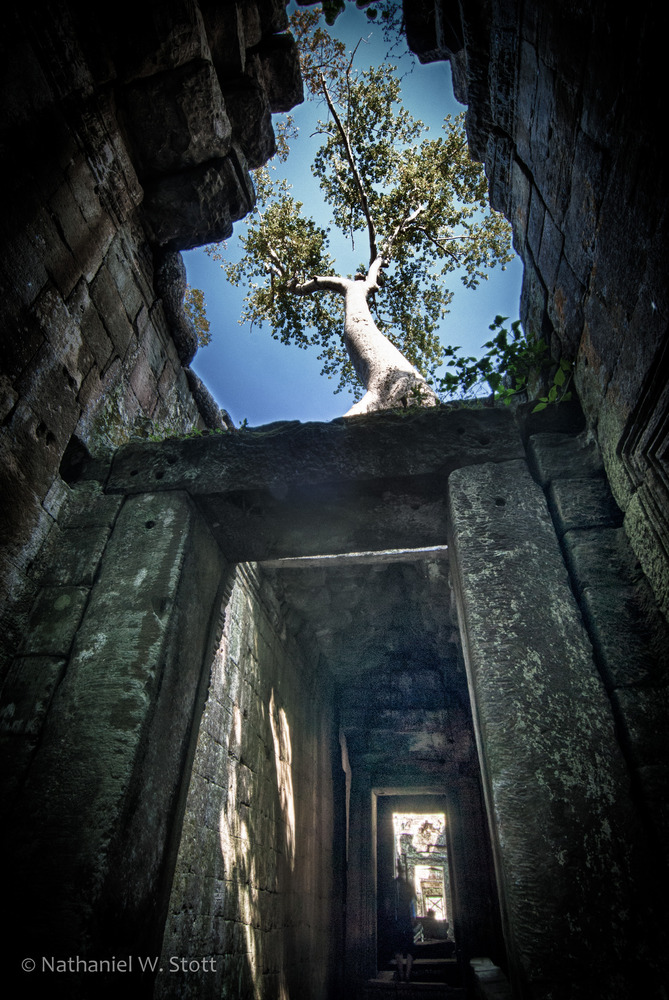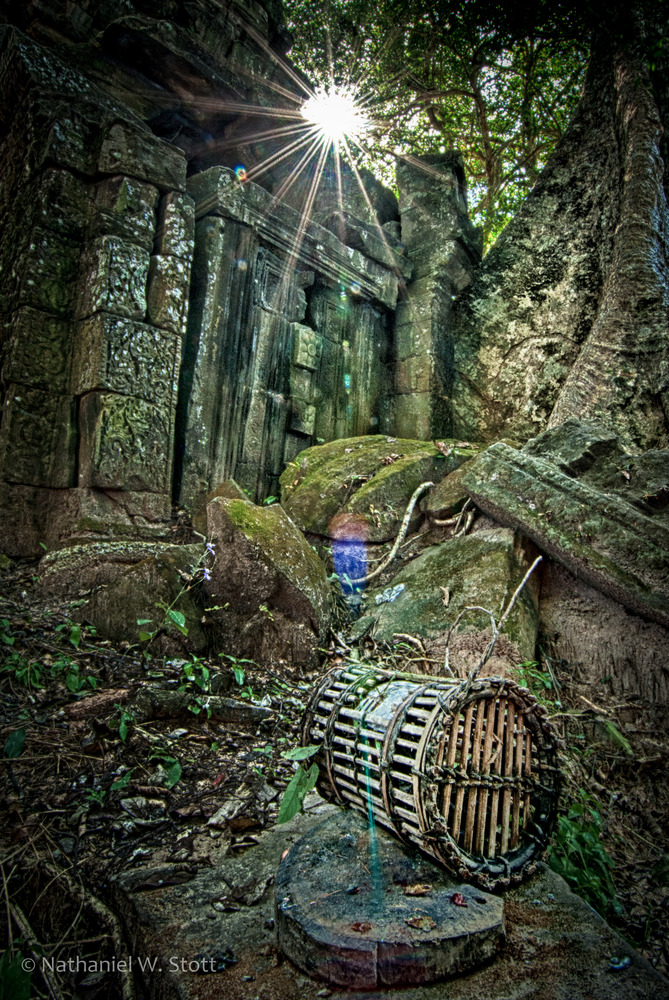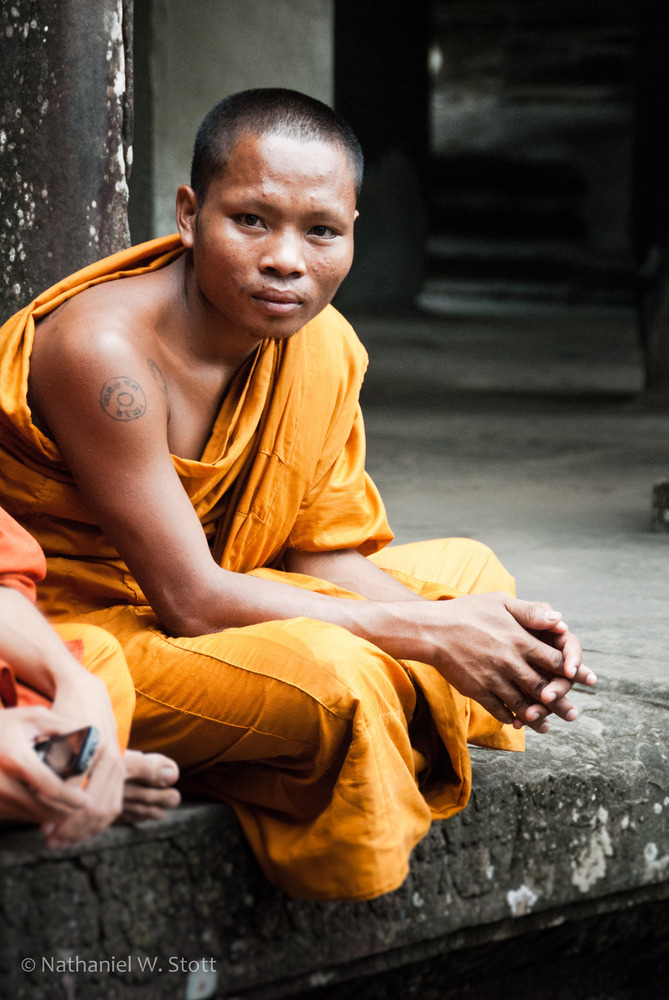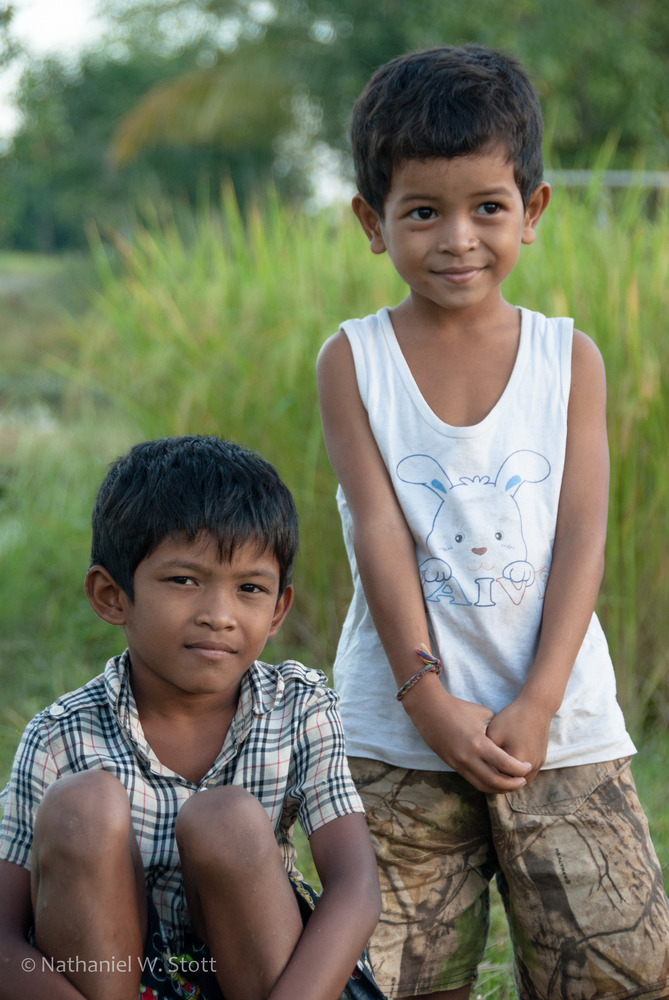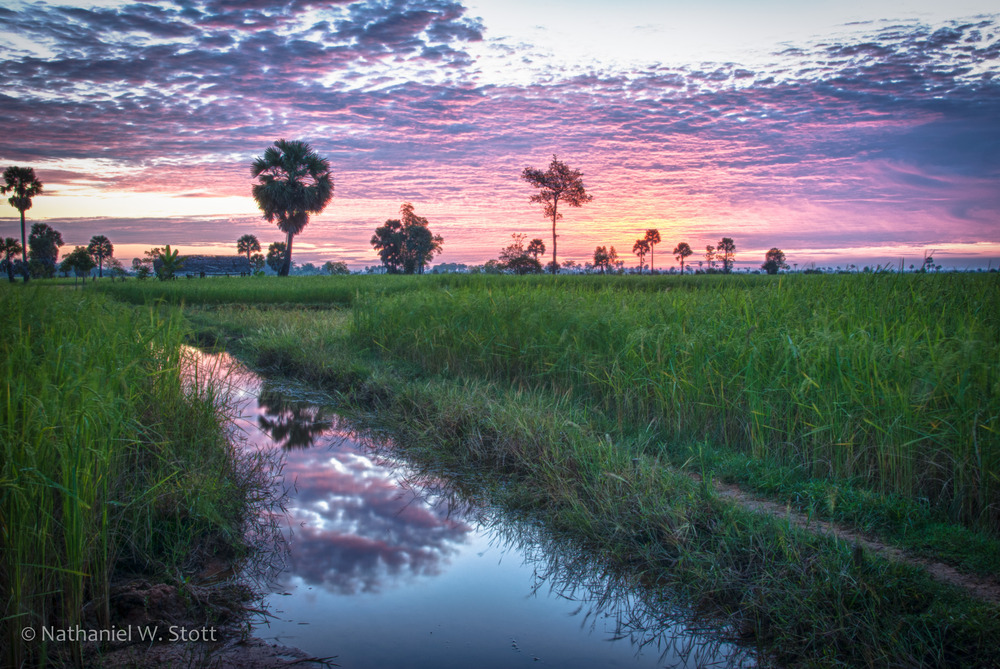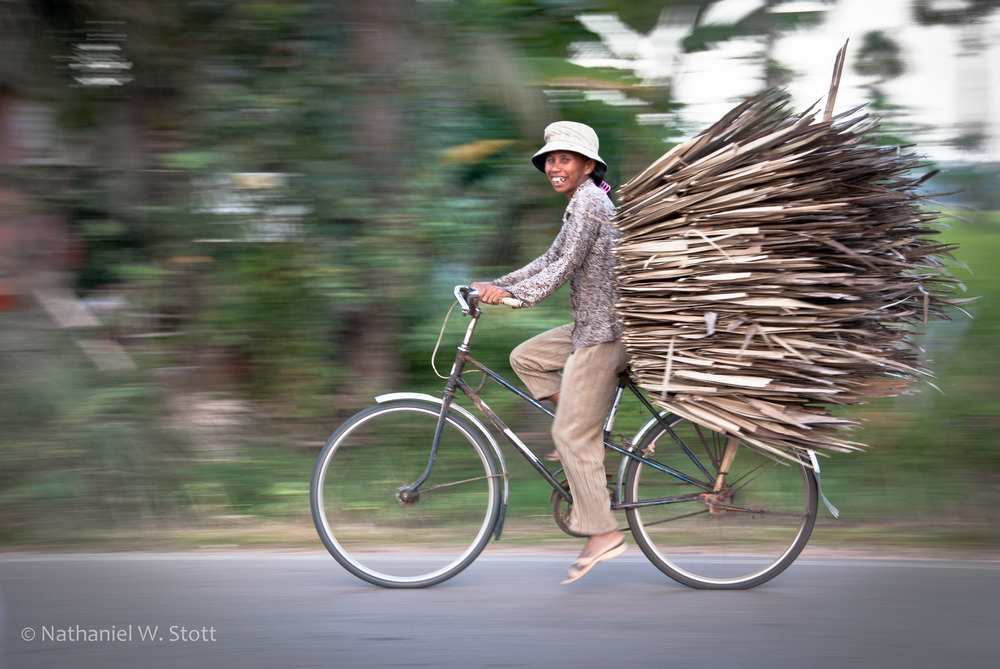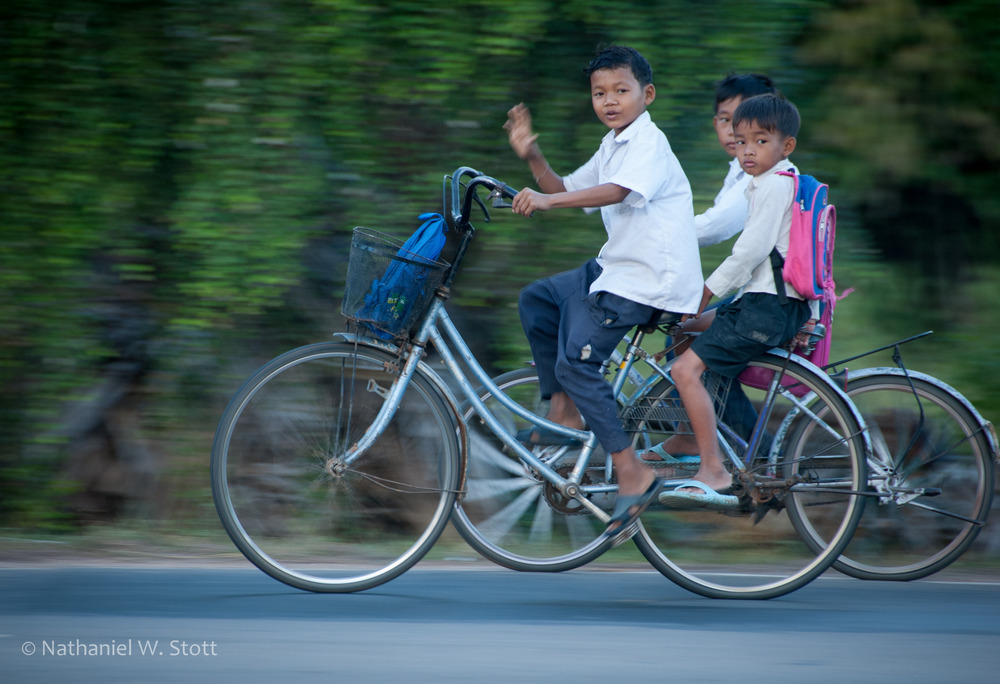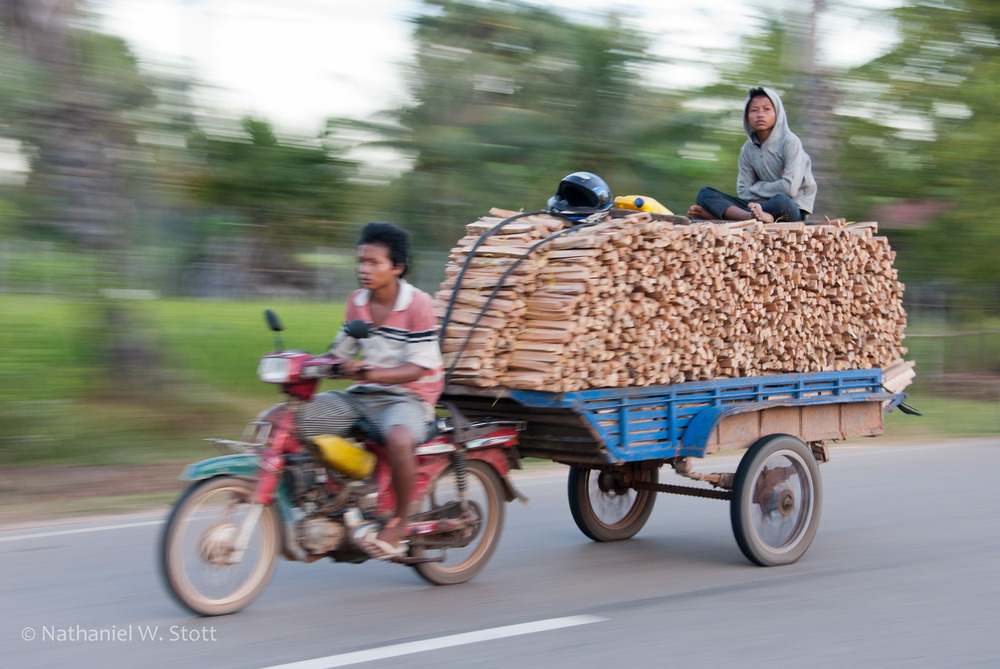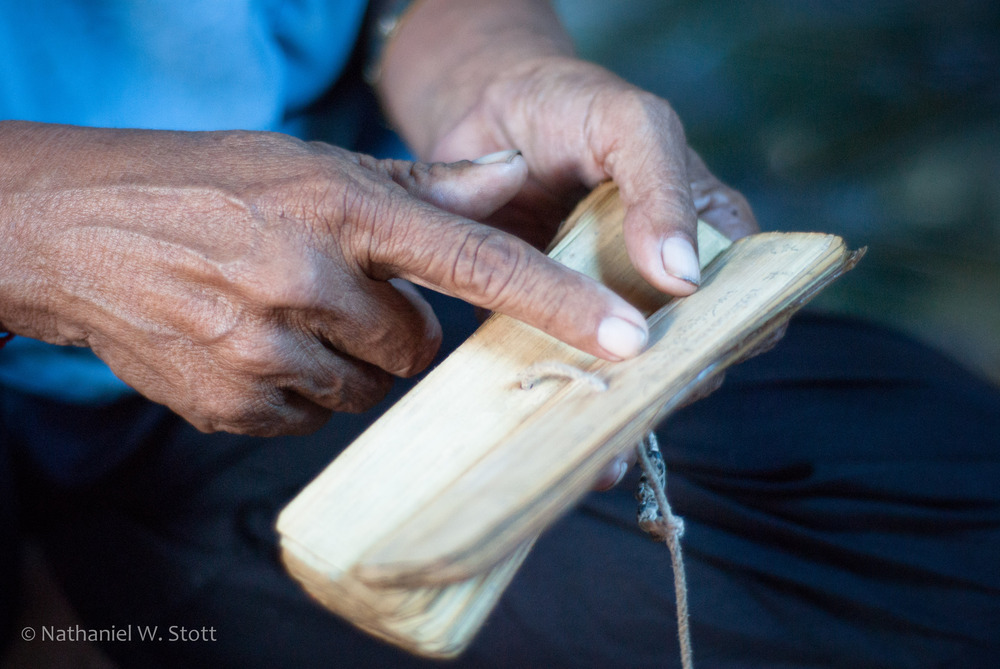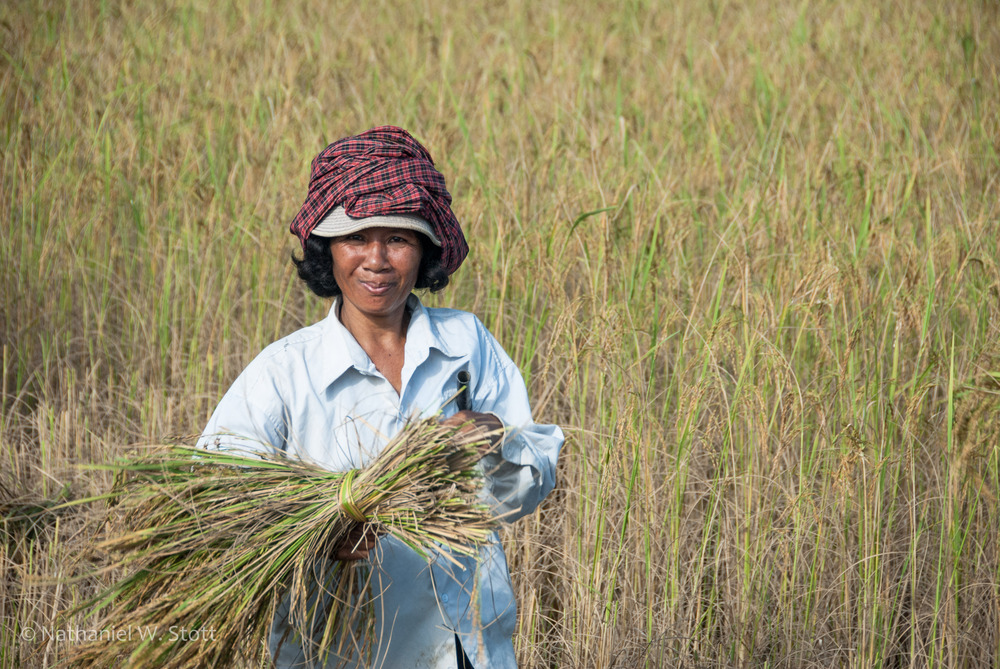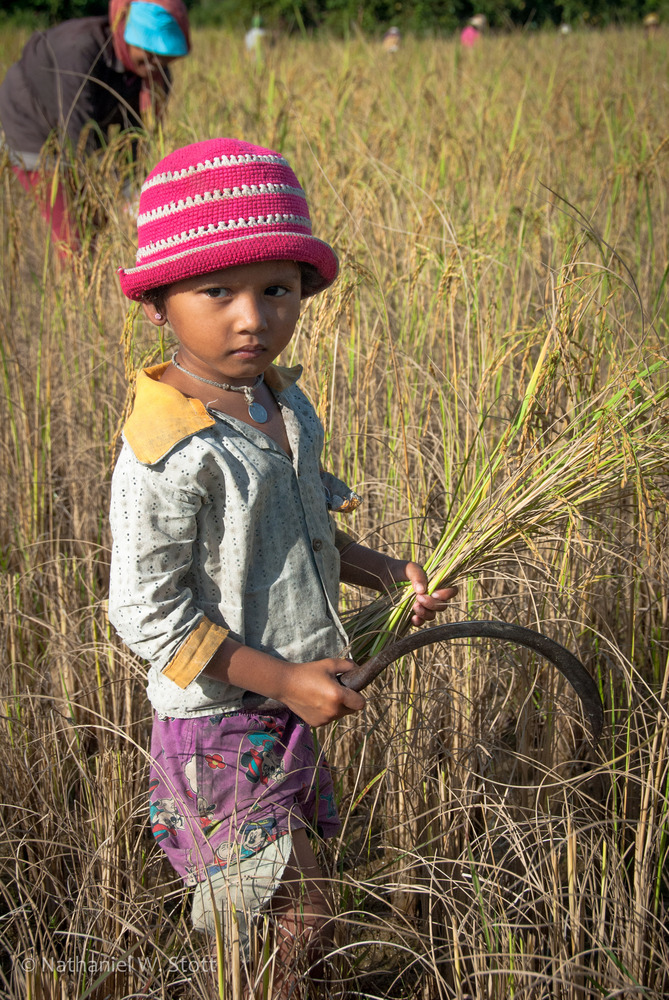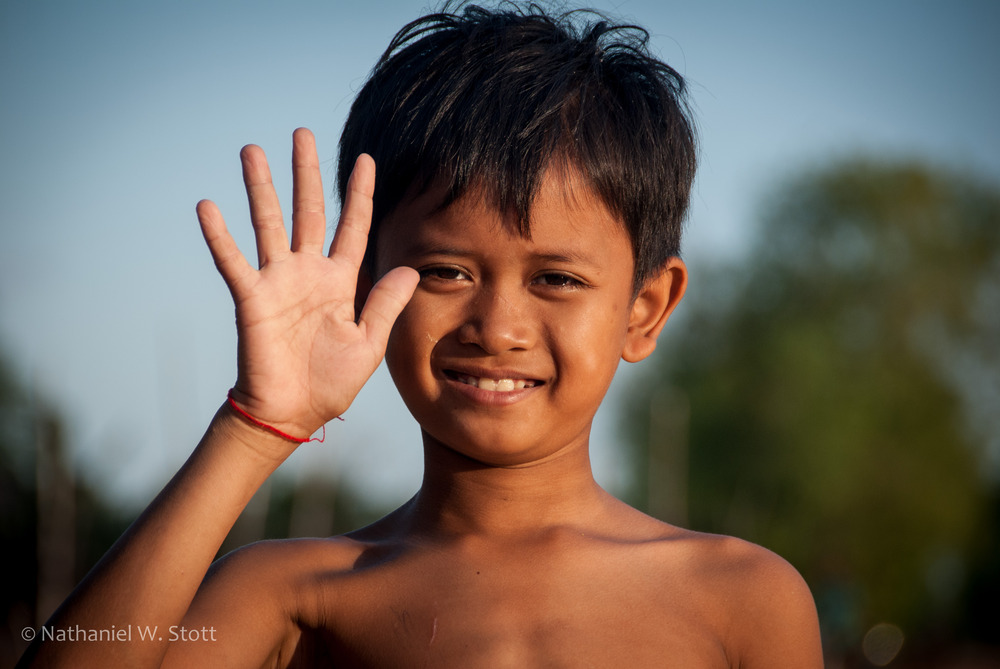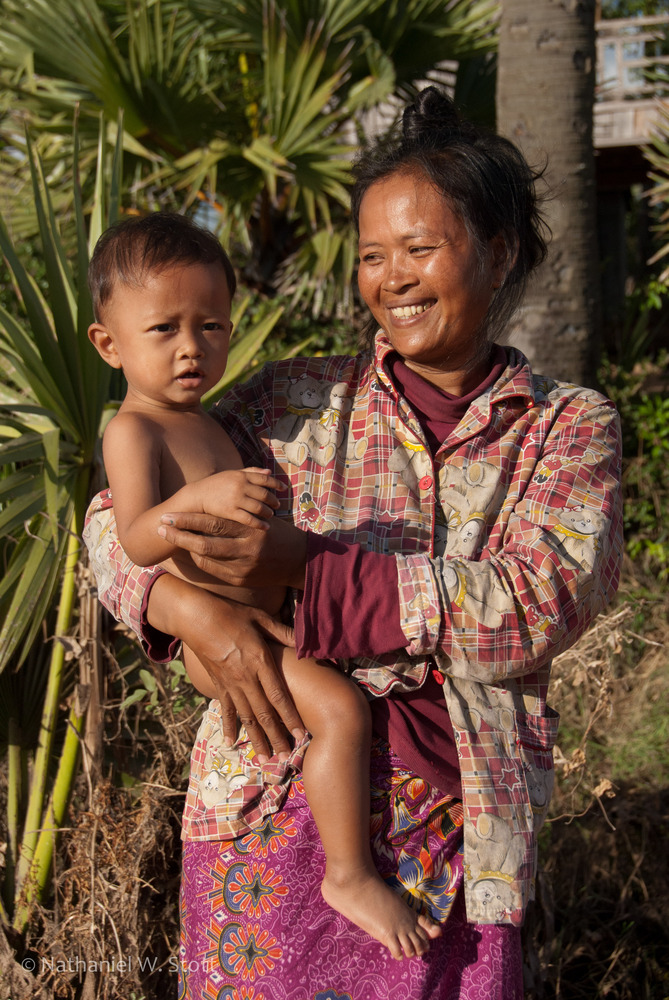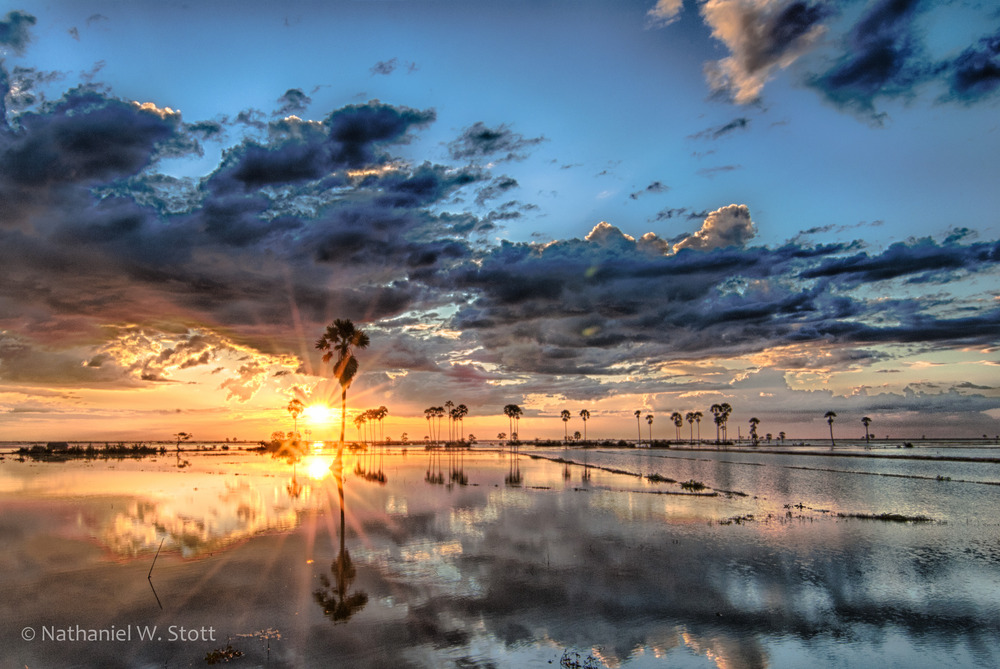24
2011O
ur final day of temple hunting took us back to some favorites, and also took us off the beaten path around the main complex of Angkor Thom. Again, our excellent guide Lim was an essential tool, taking us in, though, and around the various complexes.
Pre Rup
We woke before dawn for the rather long tuk tuk ride to Pre Rup. The temple location was an excellent venue for sunrise, and we’d confirmed it two days earlier on our early morning venture to Banteay Srei. This time we stopped and made our way around the temple, looking for the best spot from which to capture the early morning color.
During our stay in Siem Reap, there was a photo exhibition and contest going on. One of the exhibitioners had a rather impressive set of work and one very impressive image of his was the lions at the Pre Rup temple. In the right light, with the right backdrop, magic happens.
Anne and I spent a bunch of time capturing the majesty of the temple, and I helped Anne by acting as a subject, both posing for various images as well as performing action “jumps” from different levels of the temple.
Ta Nai
As the Lonely Planet puts it, “there is something of the spirit of Ta Prohm here, albeit on a lesser scale…” They have that right. The road to the temple was covered in sand and our tuk tuk driver had to make a heroic effort to both keep his moped upright and the tuk tuk from getting bogged down in sand. But the trip was worth it.
Like Ta Prohm, Ta Nei shows just how much the jungle can take back that with humans have tried to conquer. Roots and moss roam freely. Small in scale, this temple is large in atmosphere and given the general tree cover, seems like a ripe photographic subject at just about any part of the day.
Preah Khan
We concluded our tour of new temples with Preah Kahn. We exited Angkor Thom via the north gate and shortly arrived at the temple. Much like Ta Nei and Ta Prohm before it, this temple is also home to the influence of the jungle, though on a lesser scale.
Lim quickly angled back towards an area of the temple that was being restored, and into a camp used by the workers. There we came across a small fire over which was a set of frogs on skewers. Frogs are considered great eating, and the workers had set traps to catch frogs for just this purpose!
It was a beautiful temple, and I was sorry that I was feeling both dehydrated and tired because I would have loved to stay for longer or come back in the morning when the light would have been softer.
Angkor Wat and Bayon
We concluded our last day of temples with Angkor Wat and Bayon. We’d been to both of these temples before but it was only fitting that we ended where we started. These temples are simply magnificent at any time of the day and Anne and I are both sad that we’ll be leaving soon. However, we feel truly overwhelmed that we’ve had such a magnificent time exploring such a magical place!
23
2011The people of Cambodia are simply amazing. Certainly, the area around Siem Reap is famous for the temples and the grandeur of Ankor. However, it’s pretty hard to outshine the absolutely amazing personality of the people of Cambodia. We were certainly fortunate to have the help of an amazing guide to take us around and help us experience some local culture, and everywhere we went we felt welcomed.
We told Lim (our excellent guide) that we’d really hoped to get some chances to photograph rice fields at sunrise and sunset, and if we were lucky, to even have the opportunity to take pictures of the rice harvest. We set out before dawn to find a nice viewpoint for sunrise such that we could have a nice view over the rice paddies. It was an amazing sunrise to be sure.
However, what neither Anne nor I expected was the human aspect of what morning would bring. As the sun rose the bikes took to the streets, shuttling children to school and adults to work and the daily markets. We quickly turned our backs on the sunrise and focused instead on photographing the people passing us in their daily chores. While some were generally stoic, the vast majority grinned ear to ear, waving at us as they passed.
Next, we went to a small town near Siem Reap to visit a small daily market. We quickly ran into a spiritual leader for the small village and were invited into his home for a blessing. I’ll admit to feeling a bit out of my depth, trying to understand religious practices that seemed, and indeed were, quite foreign. Anne and I both took turns taking the stack of parchment, placing it on our heads, and inserting a small divider randomly into the stack. Once done, the man would read the card we chose, interpreting the story on it into either good luck or bad. In the case of bad luck, you got to go again! Anne and I were given woven bracelets to symbolize the good luck we were blessed with. All in all, an amazing experience.
On our way back towards town, we managed upon some rice harvesting and made our way into the fields. Lim worked his magic and next thing we knew he was in the field harvesting rice and we were taking pictures of the whole affair. The ladies harvesting rice were quite interested in Anne and myself, asking Lim a bunch of questions about where we were from and how old we were, even if we had grandchildren! (As we found out quickly from Lim, the Cambodian people don’t mind asking very personal questions very quickly. At one point, a gentleman who we’d only chatted with for 5 minutes started telling Lim about his time in the army fighting the Khmer Rouge)
Harvesting rice is a family affair and the ladies harvesting rice spanned two generations from grandmother to grand-daughter. I wanted to try my hand at harvesting as well so I got Lim to show me how it’s done. For what appears to be such a simple gesture, there is quite a learned art to it. The blade used to cut the rice stalk is VERY sharp, and if you don’t twist the blade away from your hand at the right time, you could easily inflict a severe wound. And cutting the clumps of rice isn’t the hard part, tying the bundles together requires real skill (that I never tried to master for fear of being laughed off the field).
To close the day, we headed back towards the Tonle Sap for sunset, hoping to find a vantage point from which we could capture a spectacular sunset. The road we camped out on was just outside a prep school so the road hosted a relatively constant stream of children riding bicycles on their way home who used the opportunity to practice saying “hello” in their best English and giggling as I waved and greeted them back.
Anne and I have visited a lot of places, but I don’t think either one of us has come away from a place and felt such a connection with the people as we did around Siem Reap. While Lim helped open us to new experiences, it certainly wouldn’t have been the same without the genuine nature of the Cambodian people. And sunset wasn’t bad either…
22
2011Our second day of temples got us to some of the more remote temples around the Angkor complex. While they are less visited, both of them are no less enchanting and dramatic than those around the core set of Angkor Wat and Angkor Thom. If you’re visiting the area, I’d argue it’s not complete without a visit to both Bandei Srei and Beng Mealea.
Bandei Srei
This temple has, probably, the best preserved carvings of any temple in the Angkor complex. Indeed, when it was found, it was assumed that the detail remaining in the carvings placed construction of the temple several hundred years later than it was actually built. It’s also unique in that it wasn’t built by a king but rather by a brahman. Regardless, it is still a jewel of a temple if for no other reason than to help you imagine the splendor of the carvings that have since weathered away at the more popular sites like Angkor Wat.
We caught first light at the temple, which helped better highlight the warm tones of the sandstone as well accentuate the carvings. Early morning also has the advantage of making the temple devoid of tourists. As we toured the complex, we were again approached by guards looking to help pad their salaries by “offering” us a tour of restricted areas of the temple for a small fee. We graciously declined.
Beng Mealea
We continued our tour at Beng Mealea. This temple really is far away from just about everything and requires a car to get to if you want to make it before lunch. Like Ta Prohm, it is a wild mix of jungle and temple and has been left far more in ruin than any other temple we visited.
Beng Mealea has the same footprint as Angkor Wat, though you’d never know it as you wander around. It is surmised that the temple was a blueprint for the construction of Angkor Wat itself. We approached via a long causeway, a weird pathway in the middle of jungle that lead to what felt like a secret place.
At the end of the causeway? A massive pile of rubble that was once a gate leading through the outer wall. The wall is now tossed, presumed to be sacked by Thai invaders in the numerous border skirmishes between the two kingdoms. A tree grows out of the center of the gate. We climbed over rocks, scaled walls, and generally explored the place like kids looking for toys buried in a sandbox.
While the images in this post hardly do the temple justice, I do consider it to be a “not to be missed” part of Angkor. It’s a little like a time capsule into how these temples were found and provides a stark reminder of just how much work has gone into putting Angkor Wat back together again.
21
2011Siem Reap is not just the gateway to the temples of Angkor. The city sits near the great lake of Tonle Sap. Most of the year, this lake is relatively small and is around one meter deep. However, during the monsoon season the lake swells to eight times that size and gets to depths of nine meters. This massive flood plain is a huge source of food for the local population, a treasure trove of freshwater fish and a natural rice paddy. Whereas most areas around Siem Reap can only grow a single crop of rice a year, the area immediately surrounding the lake is capable of three.
Naturally, villages have found ways to deal with this large tidal flux. Some are stilted villages and some are actual mobile villages of boats, though all are generally referred to as “floating” villages. As a tourist, there are several to choose from and most can be visited in a single day. Anne and I wanted to try and stay away from the tourist spots, so we veered away from the more common floating village of Chong Kneas and went for Kompong Pluk. Kompong Pluk is also home to the “Floating Forest,” which provided yet another interesting photographic aspect.
There are many outfitters that can provide access to the villages. We chose to book our tour through Beyond Unique Escapes as they offer a range of tours in the area and the owners (Fiona and Anthony) were incredibly helpful in just about every aspect of our visit to the area. It’s clear that Beyond Unique Escapes cares deeply about the local culture, and they have programs that allow you to live a day in the life of the local people.
The monsoons had only recently stopped, so the Tonle Sap was near peak flood. Whereas during some parts of the year you can drive all the way to the village, it took us 40 minutes via boat to reach our destination. The village itself has all the trappings you’d expect: temple, police station, school, homes and shops. Merchants make their way back and forth between dry land and the village such that most people are able to stay in the village for long stretches of time. Some houses even have livestock (pigs) in pins.
Boats here are as common as mopeds and bicycles around Siem Reap. Commerce takes place in boats, boats are used to visit neighbors, and even small children row boats around as if they were riding tricycles. We made our way straight through the village and directly to the forest where we moved from our powerboat to a small, wooden canoe that took us into the floating forest.
The forest of course isn’t floating, most of the year it’s a forest just like any other. However, during the monsoons the forest takes on a unique feel with trees emerging directly from the water. Locals use the arbors to keep firewood and other precious things dry. We canoed through the trees, Anne and I both working to try and capture the unique feel of the place.
After our canoe ride, we hopped back in the power boat and took a short trip to the open expanse of the great lake. I’ve only rarely been on lakes as large. Here you’re incapable of seeing the other side of the lake and I’m sure if you go further out in the lake it’s possible to not see land in any direction. After coming back to the village, we took some time to pause and take in the hustle and bustle along the main channel in the village.
We concluded our visit to the village with a stop at the temple. Unlike most of the village, the temple is built on a plot of land that’s above water level. The hill is manmade, walled up and filled with dirt. Local children have learned that this is the place to find tourists and ask them for candy or other such things. Anne and I didn’t indulge their candy dreams but we did take time to photograph them. I’m not sure how often these children are photographed but it was awesome seeing the light in their eyes when they saw images of themselves. Next thing we knew, Anne and I both had a group of child models dancing around looking for the spotlight. It was a great time, certainly a highlight of the trip.
I’d certainly recommend the village for those wishing to see a floating village but without the normal throng of tourists. If you can, go early in the morning ahead of the crowds. Only as we were leaving did we start to see other boats of tourists on the way in. Also try to stop at one of the local shops and just hang out for a while to enjoy local life. If you just speed through in a boat you’ll miss all the fun.
20
2011Quite simply, the temples of Angkor are like nothing you’ve ever seen before. Guidebooks will tell you the scale, and you’ll think you can comprehend it, but it defies words. Our visit to the temples of Angkor was split over the course of multiple days, letting us tailor our experience for photography but also avoid tourists.
The Lonely Planet tells you that you should buy your pass the afternoon you arrive in Siem Reap and then catch sunset since this gives you an extra “day” free. We didn’t do this, but Lonely Planet isn’t wrong. However, access to Phnom Bakheng is now limited so you may or may not get the acclaimed “sunset view.” I hardly think it matters; Angkor Wat at sunset is spectacular from nearly any vantage point.
Because of the vastness and diversity of the temples, I’ll be splitting posts across the days we visited. Today, I’ll focus on Bayon, Ta Prohm, and Angkor Wat.
Bayon Temple
Our first access to the park came in pre-dawn darkness. We hired a tuk tuk to pick us up before dawn and made our way to Bayon to catch first light on the faces of the temple. The only light was that from the tuk tuk headlight that illuminated the road in front of us, hardly enough to comprehend what was around us. We made our way through the imposing gate of Angkor Thom and into the jungle that covers the immense grounds. Although we couldn’t make it out, the jungle made its eerie presence felt. A couple turns later, the tuk tuk stopped and deposited us at the causeway leading to Bayon temple. We used our headlights to illuminate our steps down the causeway to the temple. Anne and I felt like explorers illuminating a long lost temple for the first time.
Bayon temple isn’t on the scale of some of the other temples, but what it lacks in size it makes up for in personality. Large faces anoint virtually every aspect of the temple, 216 of them in total. Combined, they make for an imposing structure, and one that begs for photographic attention. Morning light is great after the sun crests above the trees, providing warm rich light and adding depth to the carvings. Since the temple isn’t typically a first stop for most tourists you can also have the place mostly to yourself.
The top level provides the best access to the faces but there are many hallways that also have interesting surprises. APSARA authority workers will often bring their children with them to the temples making for interesting compositions.
Anne and I visited the temple twice, once during sunrise and once at sunset. At sunset, many of the tourists have already departed for Angkor Wat, and there’s a steady stream of Cambodians making their way home on bikes. Monks in the neighboring temple come out and eat or drink energy drinks around or in the temple, making for different yet equally amazing photography (those pictures in a subsequent post).
Ta Prohm
Ta Prohm is most famous for the large strangler figs that wrap various parts of the temple, slowly demolishing it. Ta Prohm walks a fine balance of restoration and wilderness, a curated “Tomb Raider” scene. We visited Ta Prohm mid-morning based on advice from the Lonely Planet guide book indicating that it would have fewer tourists at that hour. If that was the case, it wasn’t evident.
Regardless of tourists or heat, Ta Prohm is an incredible place to wander. The scale is hidden, both by the jungle and the ruin of the temple. Work is currently in progress at several locations around the temple, most notably at the central tower and causing some areas to be closed off to visitors.
Careful exploration will allow you to find new and interesting scenes that haven’t been photographed to death (which is difficult given the number of tourists). At mid-morning, the light was harsh enough to make most photography difficult. We also found the photogenic spots that spoke to us most were west facing, indicating that later afternoon would have been more ideal for photography.
Angkor Wat
Anne and I concluded our day with sunset at Angkor Wat. The temple faces west, which pairs nicely with the afternoon light. We arrived around 4PM thinking this would give us plenty of time to look around and scout the best locations for sunset. However, we spent over an hour just approaching the temple because of all the various people, monks, and religious ceremonies going on. If you’re going to go for sunset, plan for extra time to explore the people and culture…
The temple has undergone restoration over the last couple decades, restoring much of it and giving visitors a real sense of its original glory. The temple is surrounded by a 190m wide moat forming a giant rectangle that measures 1.3km by 1.5km. Inside the moat is a wall that runs around the entire complex. A wide causeway crosses the moat and leads to the temple from the west. There are three towers through which visitors can enter the grounds of the temple. In the right tower, you’ll find a large statue of Vishnu that was originally located on the third level of the central complex. This statue is now used as a place for locals to make offerings and provides a window into local religious culture.
Continuing through the wall, the causeway continues into the large courtyard. Libraries stand on either side. Here we found a couple monks who we engaged in conversation. One of them spoke with very good English. His friend was slightly more timid. We talked for a while, about where we had traveled, where we were going, and where their home was. When he found out that Anne was from Canada, he admitted that he loved Celine Dion and asked Anne to sing a song for him!
We continued into the temple to make the best of the quickly fading light. We bypassed the extensive Bas reliefs and went straight for the third level of the temple, which unfortunately closed at 5:30PM. As we were getting ready to leave, we did have a guard come ask us if we wanted to pay him for a “private” tour of the third level. We declined (though we were tempted; encouraging this sort of entrepreneurialism is the sort of thing that leads to archeological poaching) and headed back to town.
You can’t go wrong visiting the temple at sunset. With a clear sky you get some great light on the western aspects. Virtually any window facing the sun will allow for interesting compositions. However, I found the highlight of both days the Angkor Wat to be the people. From children to monks, they added warmth and personality to the place. I do wish I’d taken some long exposure shots on the main causeway or the steps to the third level to show the energy of the tourism, but my only regret is that we didn’t spend more time there.
16
2011When you mention Cambodia to people, one of the first things to come up is the Khmer Rouge and the genocide that happened in the country. Phnom Penh is host to two of the most famous of these genocidal artifacts: the Killing Fields of Choeung Ek and the school turned torturous prison called Tuol Sleng (also known as S-21). To visit is to step into a disturbing past.
We started our day with a trip to Choeung Ek. A relatively small plot of land on the outskirts of Phnom Penh, it is plain in appearance and our tuk tuk driver missed it entirely on the first pass. While outside appearances are unassuming, this small plot of land was the site of almost 9,000 executions carried out under the Khmer Rouge regime. Typically taken from Tuol Sleng, they were trucked here to be executed on arrival. Since bullets were expensive, most executions were carried out with simple tools like rakes, hoes, shovels, and machetes. On occasion, palm stems were used to slit throats. To mask the sounds of murder, loud music was played 24 hours a day, and strong chemicals were used to hide the smell of decay.
Walking around the site, there are many pits in the ground marking the sites of mass graves. Bone fragments, teeth, and articles of clothing lay about the grounds, exposed by rain. Periodically, these are collected and cataloged. It’s hard to comprehend the magnitude until you visit the memorial stupa where they have arranged some 5,000 human skulls in layer after layer, sorted by age, gender and ethnicity. Then the staggering scale of the genocide becomes sobering.
We left Choeung Ek and returned to the city to rest and eat before continuing our tour at Tuol Sleng. Tuol Sleng was, of all things, a school before it was pressed into service as a prison. After the fall of the Khmer Rouge, the buildings were left as they were. Rooms are empty except for the beds prisoners were chained to. There are still marks of blood on the floor where beatings took place. In one building, rooms were converted to prison cells. Each cell was just large enough to lay down. Dark and breathless, it’s hard to imagine the suffering that took place here during the summer heat. Many never left S-21 and most of those that did left for Choeung Ek.
15
2011Phnom Penh is a phenomenal city and a great start to our vacation. While it’s always shocking to go from a place like the states to a developing country, the culture shock involved in diving into Phnom Penh was nowhere near as much as Kathmandu. The city feels compact, and for all the development going on it mixes modernity with its past.
The city has a hustle and bustle to it that can seem chaotic, but is actually quite fun as people motor about on tuk tuks and mopeds. Life, it seems, is predominantly carried out on motor scooters. Families are stacked three or even five deep, televisions are carried, and food is sold on motor scooters of all shapes and sizes.
Coming from Seattle in November, the shock of the heat and humidity was relatively profound. Two or three mile walks you’d expect to easily cover in short amounts of time leave you winded, dehydrated, and ready to dive into an air conditioned café.
The architecture of the city is quite incredible. Phnom Penh has a rich and blended style ranging from French colonial to pure Khmer. The Khmer architecture is the most impressive and it stands out in the numerous temples and the Royal Palace. Where you’d expect most temples to feel like antiques, here they burst to life and explode with color. These temples are alive and a part of daily life.
If the architecture is the incredible, the food is simply divine. There are numerous trendy cafes serving all sorts of delicious food. We weren’t so brave as to try fried bugs, but here’s our short list of must have food and drink:
- Frog Legs and Quail Eggs at Slek Chak
- Tequila Black-Pepper Prawns at Metro
- A cool drink at the FCC to commune with history
- Happy hour drinks at the Quay overlooking the river, sunset, and the Tai Chi on the waterfront
We’ve only had a couple days to explore the city. So far it’s been hot, tiring, somewhat stressful, but also interesting. We keep looking forward to Angkor, so it’s hard to really feel like this is a destination unto itself. Despite that, it’s been fun to unwind, forget about work, and explore a new culture.
Next up we’ll have a post about the genocide and the Khmer Rouge since we’ll be visiting the Killing Fields and Tuol Sleng. Grim, but it’s a real part of this country and its people.
